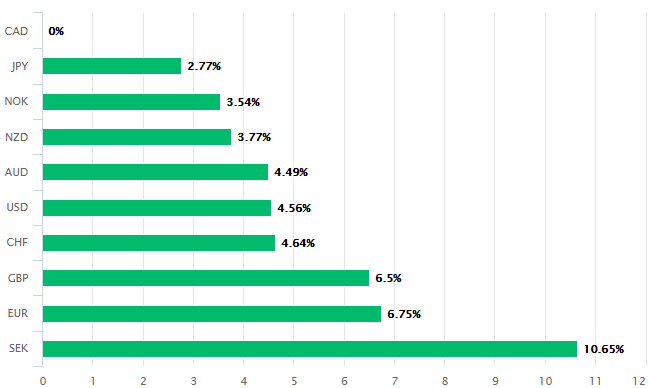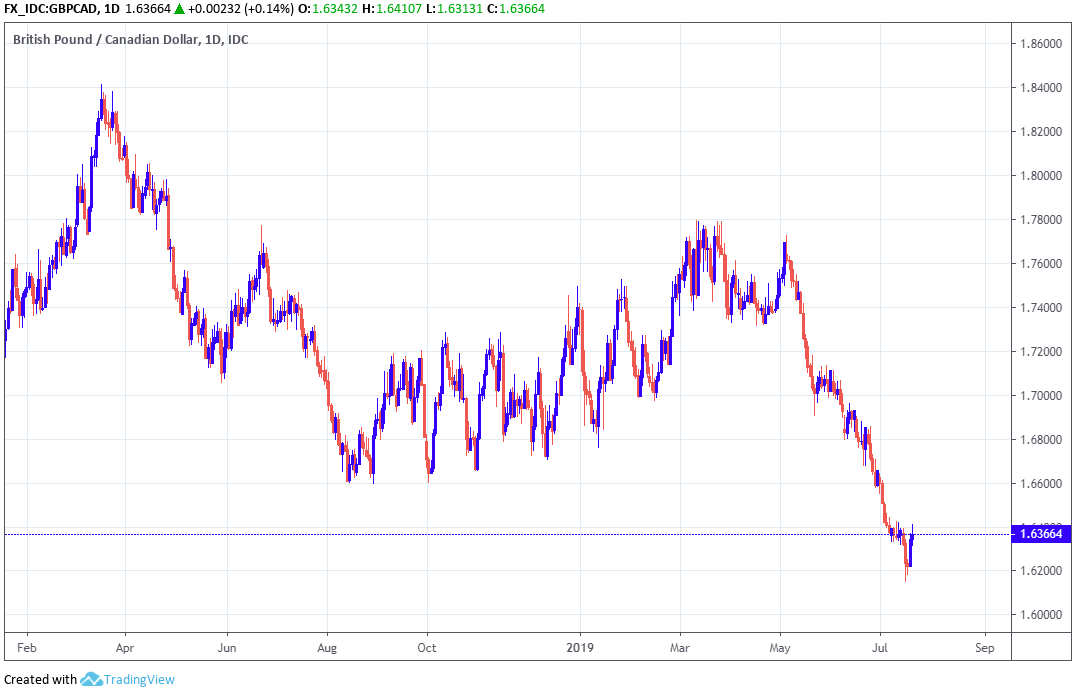The Canadian Dollar is in Retreat after Retail Sales Miss Raises Doubts about Economic Outperformance
- Written by: James Skinner
-

Image © Adobe Stock
- CAD retreats after retail data questions growth outperformance.
- Size of Federal Reserve cut at end-July key to USD/CAD outlook.
- USD/CAD bounces off long-term 'support' for now, ahead of Fed.
- GBP/CAD recovers poise, challenges 'resistance' but outlook bleak.
- Scotiabank favours more GBP declines so long as Brexit risk remains.
The Canadian Dollar retreated from recent highs against its U.S. counterpart and the Pound Friday after retail sales figures surprised on the downside for a second consecutive month, prompting the market to question whether Canada's economic outperformance may have ended in the second-quarter.
Retail sales fell by 0.1% in May when markets were looking for a 0.3% increase, which follows a then-disappointing 0.1% gain in April and sets the high street up for a weak second quarter in the wake of its earlier strong start to the year. Core retail sales, which ignore spending on cars because of the distorting impact their large prices have on underlying trends, fell a larger 0.3% when they had also been expected to rise 0.3%.
The figures mark only the first contraction for Canadian retail sales in the last four months but Statistics Canada said sales in volume terms fell by 0.5% during the May month, which is larger than the 0.3% fall in Dollar value and makes matters much worse for the market. It's volumes of sales rather than the Dollar value that are counted in the calculation of GDP growth, which means the impact on Canada's economy will be larger than the headline figures suggest.
"Retail sales couldn't continue the string of more positive than expected data," says Royce Mendes, an economist at CIBC Capital Markets. "That softness could turn out to be transitory, but from a longer-term perspective, real sales have still shown little growth since the start of 2017. The miss versus consensus should shave down tracking forecasts for second quarter GDP and weigh on the Canadian dollar today."

Above: Canadian Dollar performance Vs G10 rivals in 2019. Source: Pound Sterling Live.
Friday's data comes with the Canadian Dollar down for the session but riding high at the top of the G10 league table for 2019 as a perceived uptick in the economy and resilient inflation pressures were seen enabling the Bank of Canada (BoC) to stand apart from the developed world crowd by leaving its cash rate at 1.75% as other central banks look to support their own economies with rate cuts.
Markets care about the data because it reflects rising and falling demand within an economy, which is an important determinant of the inflation pressures that dictate interest rate policies. Changes in rates exert a push and pull influence over capital flows and short-term speculators. Capital flows tend to move in the direction of the most advantageous or improving returns, with lower rates normally seeing investors driven out of and deterred away from a currency while rising rates have the opposite effect.
"Yesterday's dovish comments by Fed BOG Vice Governor Clarida teased the market into pricing in a higher probability of the Fed cutting by 50bps on July 31. The 3M interest rate differential collapsed and our model says that it has been the most predictive factor for USDCAD over the past 3M," says Greg Anderson, head of FX strategy at BMO Capital Markets.

Above: USD/CAD rate and three-month U.S.-CA yield differential. Source: BMO Capital Markets.
The BoC emphasised risks to the economic outlook last week but stuck to its guns as far as its guidance goes, signalling that no change in its interest rate is likely in the short-term. It says the current 1.75% cash rate is "accomodative" for the economy and that it will pay particular attention to "developments in the energy sector and the impact of trade conflicts on the prospects for Canadian growth and inflation" when making future interest rate decisions.
Meanwhile, the Federal Reserve is widely expected to cut its interest rate on July 31 although there's been significant uncertainty over whether it will cut U.S. rates to 2.25% or 2.5%. The difference, and outlook beyond there, is significant for markets, which are convinced momentum is ebbing from the economy, that inflation pressures are weakening and expectations of future prices pressures will fall further.
"Our view is that if the Fed were to cut more (either 50bps in July or 75bps total), the BoC would respond with a 25bp cut of its own in order to prevent the Fed Funds overnight rate from dropping below Canada's overnight rate. So with that in mind, we'd still be USDCAD buyers rather than sellers in the 1.3000 to 1.3050 region today," BMO's Anderson says.

Above: USD/CAD rate at daily intervals with technical indicators. Source: RBC Capital Markets.
The USD/CAD rate was quoted 0.46% higher at 1.3095 following the release after extending an earlier 0.08% gain, but it's down 3.7% for 2019. The Pound was 0.22% higher against the Loonie, at 1.6385, but has fallen 5.8% this year.
"USD/CAD is approaching a critical long-term support level near 1.3000 as policy divergencebetween the Fed and BoC appears. Crude oil remains a key driver for CAD," says George Davis at RBC Capital Markets.
Pound Sterling has corrected higher against the Canadian Dollar in recent days after parliament managed to further impede the path toward a 'no deal' Brexit for the UK's incoming Prime Minister and the EU signalled it might be open to renegotiating aspects of the withdrawal agreement, which have both helped reverse some of the damage done during a punishing start to the week.

Above: Pound-to-Canadian-Dollar rate shown at daily intervals.
"GBPCAD has bounced. The GBP traded decently higher off of Monday’s low and effectively held steady on the day Tuesday, forming a “doji” candle (stalling signal)," says Eric Theoret, a technical analyst at Scotiabank. "We see resistance at 1.6330/50 intraday and channel resistance at 1.6435."
Sterling price action reflects the ebb and flow of market hopes that the saga being written in Westminster and Brussels would ultimately culminate in a 'soft Brexit' of one kind or another, although as things stand this July, such a thing is looking less likely in the eyes of the currency market. Fears over the exit path have seen the Pound become completely unresponsive to traditional economic fundamentals.
Tuesday saw the Office for National Statistics announce that wage growth was its fastest for 11 years in the three months to the end of May, which normally would have encouraged speculation about interest rate hikes from the Bank of England and lit a fire under the British currency. However, the Pound fell in the wake of Tuesday's economic numbers. Thursday's strong retail sales figures were accompanied by a rally higher, but also signs of movement from the EU on the withdrawal agreement.

Above: UK retail sales growth alongside wage growth rate. Source: Pantheon Macroeconomics.
"We have reached the bear target for the GBP we outlined in June, following the break lower in the GBP below the base of the late May consolidation but we continue to feel that the risk of an overshoot to the 1.57/1.58 area, tested in 2016/18, remains very real," warns Scotiabank's Theoret.
Speculation over the health of the UK economy has been mounting of late. Many have forecast a contraction for the second-quarter while almost all economists have said the economy will have stalled if it didn't shrink.
GDP figures released earlier in July showed output rising just 0.3% in May, after already having fallen a larger 0.4% in April. Those figures mean the economy has had to run faster in order just to stand still for the three months to the end of June. Consumer spending accounts for a large portion of GDP so this week's strong retail sales could yet help produce the additional gain needed for a contraction to be avoided.
However, even if economy dodged a bullet it might not be enough to help a Brexit-transfixed Pound, given the October 31 expiry of the Article 50 negotiating period is drawing closer and the clamour is growing louder among some in the Conservative Party for a 'no deal' Brexit in the absence of changes to the withdrawal agreement.
"Sterling has squeezed higher over the course of this week but we think a meaningful recovery remains out of the question while Brexit risks remain," says Shaun Osborne, chief FX strategist at Scotiabank. "Chancellor Merkel stated today that the Withdrawal Agreement could be “over written” if a Brexit deal can be reached and said the UK would get more time, if needed to reach a deal. This all sounds quite conciliatory for Boris Johnson who remains primed to assume the position of Prime Minister; the Tory party leadership results will be released early next week."

Above: Pound-to-Canadian-Dollar rate shown at weekly intervals.
Time to move your money? Get 3-5% more currency than your bank would offer by using the services of foreign exchange specialists at RationalFX. A specialist broker can deliver you an exchange rate closer to the real market rate, thereby saving you substantial quantities of currency. Find out more here.
* Advertisement









